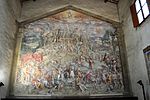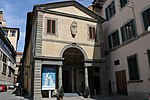Santa Maria Nuova, Pistoia
13th-century Roman Catholic church buildings in ItalyAll pages needing cleanupRoman Catholic churches in PistoiaRomanesque architecture in TuscanyWikipedia introduction cleanup from July 2021

Santa Maria Nuova is a Romanesque-style, de-consecrated church located on Via Manrico Ducceschi #2 and Largo Santa Maria, in Pistoia, region of Tuscany, Italy.
Excerpt from the Wikipedia article Santa Maria Nuova, Pistoia (License: CC BY-SA 3.0, Authors, Images).Santa Maria Nuova, Pistoia
Via Manrico Ducceschi, Pistoia
Geographical coordinates (GPS) Address External links Nearby Places Show on map
Geographical coordinates (GPS)
| Latitude | Longitude |
|---|---|
| N 43.930899 ° | E 10.921087 ° |
Address
Santa Maria Nuova
Via Manrico Ducceschi
51100 Pistoia
Tuscany, Italy
Open on Google Maps









